Three Presidents, a single paper money issue: the paradox of the “Carbajal bonds” (Obligaciones Provisionales del Erario Federal)
by Cedrian López-Bosch Martineau
 |
 |
 |
| Victoriano Huerta | Francisco Carvajal | Venustiano Carranza |
The Mexican Revolution was full of paradoxes. An example of these were the Obligaciones Provisionales del Erario Federal (provisional promissory notes of the federal treasury), aka “Carbajal (sic) bonds”. In a period where one side disqualified and did not recognize what the other was doing, paradoxically this single issue linked a few of them; it was planned by Victoriano Huerta, put into circulation by Francisco Carvajal and, finally, recognized and withdrawn by Venustiano Carranza.
Creation
On 2 July 1914 the Chamber of Deputies discussed and approved a bill submitted by the Secretary of Finance and Public Treasury, Adolfo de la Lama, to issue “six percent Mexican gold amortizable bonds of 1914”. These bonds were intended to fulfill the financial commitments and maturities of railway bonds, domestic debt, irrigation and agricultural works; the debt service repayment; the payment of salaries to public officials and, to meet the extraordinary expenses Victoriano Huerta’s government was incurring to fight the revolutionary uprising.
Four days later, the Official Gazette published the decree of the Law authorizing the issue of 60 million pesos in 6% amortizable bonds, as well as the so-called Obligaciones Provisionales del Erario Federal. This would be a 10-year internal debt guaranteed with the revenue of the stamp tax. The Treasury would issue these bonds and repay them to the bearer on demand with gold currency, twice a year, in Mexico City, London and other places defined by the government.
Bonds and provisional certificates
The Ministry of Finance was in charge of defining the features carried by these bonds, such as the values, numbers, letters, colours and security codes to ensure their use and authenticity. On 8 July the Official Gazette published the secondary regulation which covered five types of bonds:
| Features for the 6% bonds | ||||
| Colour | Letter | Number | Value Mexican Gold |
Total value |
| Green | A | 1 to 200000 | 50 | $10,000,000 |
| Pale blue | B | 200001 to 300000 | 100 | 10,000,000 |
| Orange | C | 300001 to 330000 | 500 | 15,000,000 |
| Red | D | 330001 to 345000 | 1,000 | 15,000,000 |
| Brown | E | 345001 to 347000 | 5,000 | 10,000,000 |
| Total | $60,000,000 | |||
In accordance with the Law and its Regulations, on the obverse, these bonds should bear the signature of the federal treasurer and the assistant treasurer, and on the reverse, a selection of the main articles of the 6 July Law (1st, 2nd, 3rd, 5th, 6th, 7th, 8th and 10th). Each bond would have twenty coupons for the same number of semesters with the amount and expiration date.
While they were printed, which was customary to be done at one of the largest security printers in the USA, such as the American Bank Note Company, the Law considered issuing provisional certificates, printed by the Stamp Printing Office located at the National Palace in Mexico City. These certificates would be exchanged for the definite bonds when they were ready.
According to the same Law, the bonds could serve as a guarantee for issuing 10 million pesos monthly in Obligaciones Provisionales del Erario Federal, up to 85% of the total bond issue. These promissory notes would be unlimited legal tender documents of forced circulation promising to pay to the bearer on demand 1, 5, 25 or 50 pesos each. Once again, the Ministry of Finance was responsible for determining the values, features, security codes, etc. The regulation specified that the Obligaciones Provisionales should be printed, engraved or lithographed on special paper with similar dimensions to banknotes.
| Features of the Obligaciones Provisionales del Erario Federal | |||
| Letter | Value | Serial Number | Total amount |
| A | 1 | 1 to 5000000 | $5,000,000 |
| B | 5 | 1 to 2000000 | 10,000,000 |
| C | 25 | 1 to 400000 | 10,000,000 |
| D | 50 | 1 to 100000 | 5,000,000 |
| Total | $30,000,000 | ||
Huerta no longer had time to issue the bonds nor the Obligaciones Provisionales. He resigned from the Presidency on 15 July and left Mexico only five days later. His successor, the Minister of Foreign Relations, Francisco Sebastián Carvajal y Gual, in charge to transfer power to Venustiano Carranza according to the Teoloyuan Treaties, continued with this project and issued both the provisional certificates and the Obligaciones Provisionales. That explains why they were referred to by newspapers and some officials as “Carbajal (sic) bonds”, or simply “bonds”, although in reality they do not refer to the bonds, but to the Obligaciones Provisionales.
I am not aware of the existence of bonds - or at least specimen bonds - printed by a US security printing firm; most likely, officials did not have time to request them, but at the Historical Fund of the Treasury of the Federation there is a book with the provisional certificates issued during the brief presidency of Carvajal. As per the stubs on those books, there were only seven issued, between 25 and 31 July. They have the autographed signatures of the treasurer Gonzalo Manero, and of the sub-treasurer Francisco P. Montes de Oca, who took up his office on the 23rd of that same month.

Provisional certificate of the "six percent Mexican gold amortizable bonds of 1914" (source: TESOFE's Historical fund)
Obligaciones Provisionales
On the same date, President Carvajal issued a memorandum modifying two articles from the secondary regulation, distributing the denomination according to the following criteria:
| Obligaciones Provisionales del Erario Federal | |||
| Letter | Value | Serial Numbers | Total amount |
| A - I | $1 | from 1 to 1000000 | $1,000,000.00 |
| A - II | from 1 to 100000 | 1,000,000.00 | |
| A - III | from 1 to 1000000 | 1,000,000.00 | |
| A - IV | from 1 to 1000000 | 1,000,000.00 | |
| A - V | from 1 to 1000000 | 1,000,000.00 | |
| B - I | $5 | from 1 to 1000000 | 5,000,000.00 |
| B - II | from 1 to 1000000 | 5,000,000.00 | |
| C | $25 | from 1 to 400000 | 10,000,000.00 |
| D | $50 | from 1 to 100000 | 5,000,000.00 |
| E | from 100001 onwards | remnant | |
The main vignette on the Obligaciones Provisionales consists in an eagle perched on a prickly pear cactus devouring a rattlesnake, surrounded by the legend “Estados Unidos Mexicanos”. The ornamented margins include the denomination in number on six different places and the main legend says:
“provisional promissory notes of the federal treasury. Letter ... – Serial Number ... – The Treasury of the Federation Will pay to the bearer … Pesos (in number and letter). – This promissory note is guaranteed for the same amount by the six percent Mexican gold amortizable bonds – 1914 –10 years, according to the decree issued on 6 July 1914, and will be redeemed in the terms of such decree. – Mexico, 25 July 1914.”

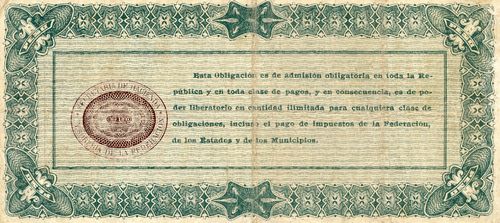 M1251a $1 Obligación Provisional
M1251a $1 Obligación Provisional

 M1252 $5 Obligación Provisional
M1252 $5 Obligación Provisional
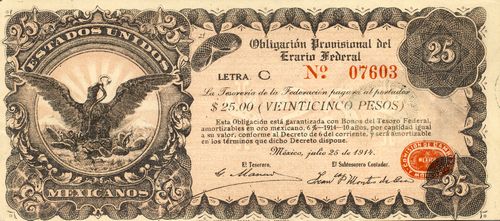
 M1253a $25 Obligación Provisional
M1253a $25 Obligación Provisional

 M1254 $50 Obligación Provisional
M1254 $50 Obligación Provisional
Below the legend, the complete signature of the treasurer Gonzalo Manero and the manuscript name of the assistant treasurer Francisco P. Montes de Oca with their respective titles are printed.
All denominations have slightly perceptible backgrounds in different colors, while margin designs, rosettes and texts are printed in black ink, except for the folio, the complementary number of each series (only on the one and five pesos), and a small rosette with the name of the Exchange and Currency Commission which are printed in red. Below the margin, the name of the Stamp Printing Office – Mexico appears centered.
The reverse is printed in different colors for all denominations. The margin is decorated with rosettes in the four corners with the denomination. Within the margin, there is a text box with an oval countersign consisting in a rosette with the word Mexico and the names of the Ministry of Finance and the Treasury of the Federation, with the imprint Government Printing Office in micro-letters, and the legend “this promissory note is of obligatory admission across the Republic and for all kinds of payments, and consequently, it is of legal tender for any kind of obligations, including the payment of taxes to the Federation, the States and the Municipalities.”
It was announced that the notes would be put into circulation on 31 July by paying Federal employees a third of their salaries in the new currency. Because of the shortage of special paper the first run was 40,000 $1, 30,000 $5 and 10,000 $50 notes, making a total of $1,650,000. These were printed on “extrasuperfino” paper, but future runs would be on better quality paperEl Imparcial, Núm. 6522, 1 August 1914.
Apparently only a fraction of the Obligaciones Provisionales from the abovementioned memorandum were issued, since Carvajal left the presidency on 13 August 1914, when the revolutionary forces seemed to take control of most of the territory.
Before the split of the revolutionary forces at the Convention of Aguascalientes, which separated the Constitucionalistas led by Venustiano Carranza from the other leaders who defended the Convention, the acting Secretary of Finance, Felicitos Villarreal, presented a plan to Carranza suggesting that the “Carbajal bonds” should not be recognized.
On 19 August, Pascual Ortiz Rubio, newly installed in charge of the Oficina Impresora de Estampillas in Mexico City, said that $4,000,000 in Obligaciones ready for circulation, would not be released and would remain in the Oficina until they were destroyedEl Demócrata, Segunda Época, Tomo II, Núm.147, 28 August 1914.
By late August the Obligaciones were being refused by shopkeepers and anxious people crowded the Tesorería General in an attempt to get them changed for Constitutionalist notes. In an interview with El Pais subsecretario Felicitos Villarreal said that he was studying the subject and his personal opinion was that they should continue to circulate until a decision was takenEl País, Tomo I, Año XIV, Núm. 4657, 22 August 1914: Nueva Patria, Tomo I, Núm. 14, 9 October 1914. When the revolutionaries took Mexico City Carranza had changed his attitude to notes of the banks of issue. He also realized the effect that disowning them had on the poorer classes and so accepted both banknotes and these Obligacions Provisionales, in a circular on 27 August 1914.
Reynoso issued a declaration on 15 October on the numbers of the notes put into circulation. Unfortunately, when the declaration was published in El Constitucionalista on 16 October and was reproduced in other papers, the numbers for the $25 value, if they had been included in the original declaration, were missed outEl Constitucionalista, Tomo II, Núm. 43, 16 October 1914. This mistake was repeated over the next couple of monthsAHTlax, Fondo Histórico, Sección Revolución Régimen Obregonista, Serie Hacienda y Guerra, Caja 46, Exp. 53, Fs. 7; Boletín Militar, Tomo II, Núm. 83, 21 October 1914 (which also manages to screw up the $100 figures); El Democráta, Veracruz, Tomo I, Núm. 77, 31 December 1914; El Dictamen, Veracruz, Año XVII, Núm. 1377, 1 January 1915.
The correct information was given in a circular on the following day (relatively correct – it refers to $20 notes instead of $25Boletín Militar, Tomo II, Núm. 90, 29 October 1914) , viz:
| Obligaciones Provisionales del Erario Federal recognized by the Constitutionalist forces |
|||||
| series | from | to | total number |
total value |
|
| $1 | A | 1 | 360000 | 360,000 | $ 360,000 |
| $5 | B | 1 | 390000 | 390,000 | 1,950,000 |
| $25 | C | 1 | 40000 | 40,000 | 1,000,000 |
| $50 | D | 1 | 100000 | 100,000 | 5,000,000 |
| $ 8,310,000 | |||||
This was confirmed in a notice from the Secretaria de Hacienda on 23 October. When Carranza, on 13 November, ordered his military commanders to prevent the circulation of Huertista issues, he exempted these Bonos.
On 13 November, Reynoso, the Tesorero General de la Nación reported that out of a total issue of nearly $8,000,000 of the so-called “bonos” about $5,000,000 worth had been redeemed and burned by the finance authoritiesThe Mexican Herald, 14 November 1914: El Pueblo, 14 November 1914 . Another $501,260 was destroyed on 14 Novemberibid..
The Obligaciones thus entered the canon of notes accepted by the Constitutionalists and were included in various pronouncements, for instance, by the governor of the Federal District on 1 December 1914. They were one of the twenty issues that Carranza on 28 April 1916 decreed should be deposited in the Tesorería General de la Nación, the Jefaturas de Hacienda and the Administraciones Principales del Timbre. On 4 September 1917 Carranza still included them when he prohibited speculation in former issues.
It is common to find decrees of local authorities that reproduced those of Carranza recognizing these bonos among other issues. Curiously, it seems that at least one of them went further and revalidated them with a circular seal stating REVALIDADO. So far, I have not located more information about these revalidated notes.
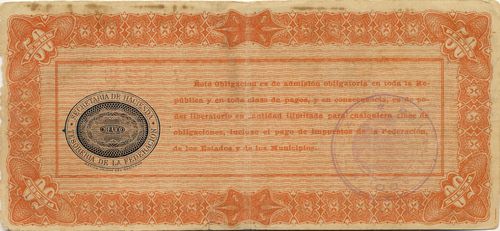
overstamp on the Obligaciones Provisionales (courtesy of Ricardo de León Tallavas)
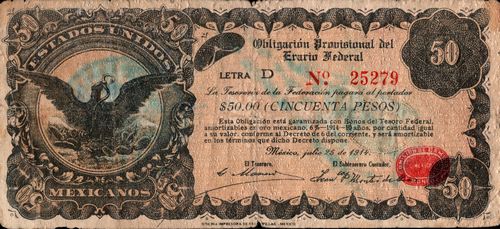
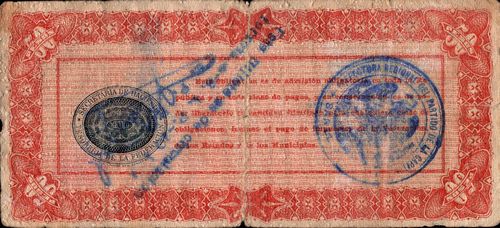
M1254a1 $50 revalidated by the Prefectura Regional del Partido de la Capital, San Luis Potosí
This issue not only experienced a recognition problem from the different authorities, but also a lack of confidence and acceptance from the general population. As said, by late August the Obligaciones were being refused by shopkeepers and anxious people crowded the Tesorería General in an attempt to get them changed for Constitutionalist notes. In early October, amid rumors that counterfeit bonos were circulating a newspaper held an interview with Undersecretary José J. Reynoso who said that this was a mistake. His department had issued the serial numbers of the bonos that had not been put into circulation and this was misread as counterfeit. In fact only $5,170,000 had been issued and was mainly in the hands of the poorer classes. These were expected to disappear quite quickly as they would be exchanged for Gobierno Provisional de México notesBoletin Militar, Guadalajara, Tomo II, Núm. 71, 7 October 1914. The notes were still being refused by some, especially foreign, stores but Reynoso reiterated that, while the new currency was issued, they were of forced circulation but were gradually being withdrawnNueva Patria, 9 October 1914. In the Ministry of Finance’s memoirs there is a memo from Reynoso to the manager of Mexico’s electric trams company, clarifying that there had been no forgeries of this issue and, therefore, there was no reason for the drivers to refuse them. Furthermore, he recommended not to be guided by the serial number, but by the security mark at the reverse, which constituted an anti-forgery measure that helped to authenticate them.
In fact, the mark that Reynoso referred to is interesting in itself, as it links another faction during the revolution. It not only appears on the Obligaciones Provisionales issued by the government of Carvajal, but also on Carranza’s Mexico City Provisional Government issue, and on some notes issued by the Conventionists. These three issues were produced and stamped by the Treasury Printing Office; most likely the Constitutionalists did not have time to prepare another stamp to validate their issue and used the one they found in the printing office when they took Mexico City. Possibly, the cliché was left by this faction when they moved to Veracruz at the schism on the Convention and then was recovered and used by the Conventionists when they occupied Mexico City and subsequently moved to Cuernavaca.

Obligationes Provisionales (July 1914)

Gobierno Provisional in Mexico City (September 1914)

Conventionist Government (October 1915)
Withdrawal
On 27 March 1915, Carranza listed the Obligaciones Provisionales among the issues that would cease to be legal tender as of 1 July of that same year, a date extended to September 30 by another decree of 19 June. Then, the Obligaciones Provisionales were to be exchanged by the General Treasury and other offices defined by the Ministry of Finance. Nevertheless, apparently they kept in circulation for some months.
In 1916, when Carranza was about to launch the so-called infalsificables, in a decree dated 28 April he again listed all the issues that his government would redeem, and the “Carbajal bonds” were once again among them. All these notes were to be deposited at the General Treasury, the Treasury Headquarters and the Main Stamp Revenue Administration by 30 June 1916 for later exchange. The holders had to carry three copies of the list of notes to be exchanged, one would be returned to the holder of the notes, another would remain at the collecting office and one more would accompany the notes which were sent to the Monetary Commission for its revision, cancellation and the authorization of the exchange. There might be somewhere a file in an archive which includes the number of Obligaciones Provisionales redeemed and destroyed.
This is how this brief issue connects characters as antagonistic as Huerta and Carranza and its features are common with the old regime and to opposing factions such as the Constitutionalistas and the Conventionistas, showing some of the many paradoxes of the Mexican Revolution.
Counterfeits
In July 1915 the police discovered a major counterfeiting operation that include banknotes, bonos, sábanas, cartones and even revenue stamps. Various suspicious people were recorded entering and leaving a house at 3a calle de Altamirano 183, in the suburb of Tacubaya, and the police gained enough evidence for a raid, though the suspects got wind of this and most managed to escape, foiling the police. Inside they found all the apparatus and ingredients necessary for counterfeiting (Cámara, aparatos de amplificar, retocar, revelar, en las fotógrafas; torno, cinceles, escoplos, punzones, aparatos de niquelar y grabar; todo un arsenal de utensiles y substancias químicas; en fin, papel imprenta y lo necesario para reproducir los billetes, timbres y moneda).
The counterfeit Obligaciones could not be distinguished, even by the greatest experts, but luckily the bonos had not been put into circulation as they had only managed to do the designs, photographs and other preparationsEl Renovador, 3 July 1915. The newspaper article has photos of the workshop and blowups of one of the bonos and of the Secretaría de Hacienda seal.



